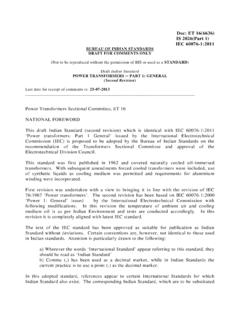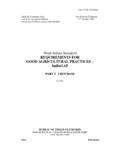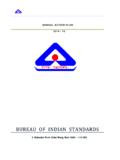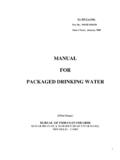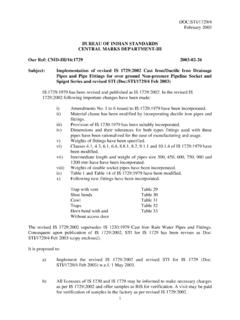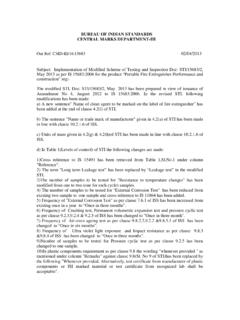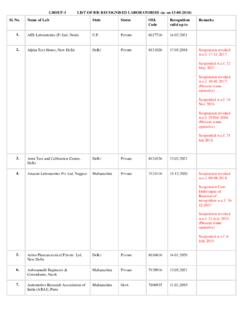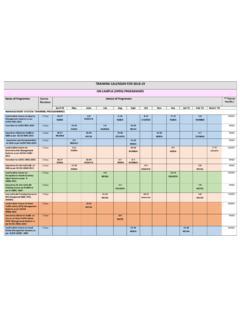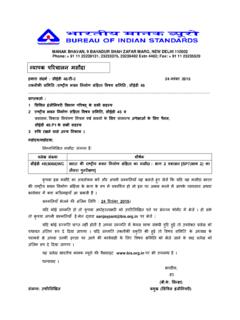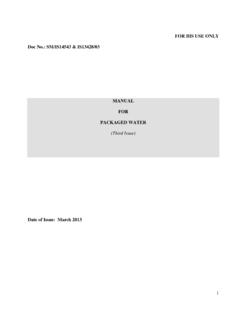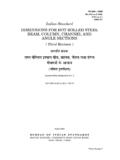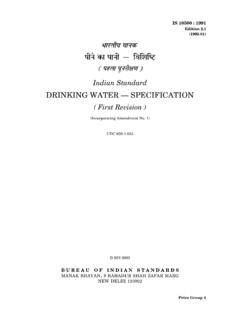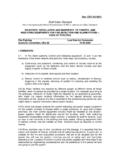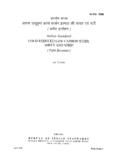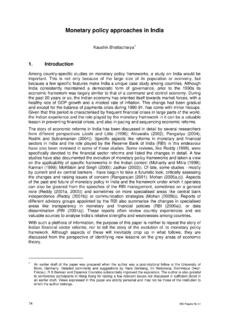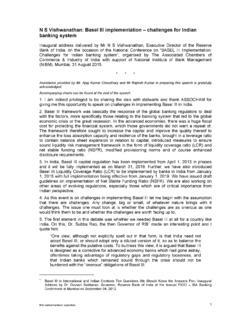Transcription of Draft Indian Standard
1 { E { S x . n . | J | h Y { x . n x E : 13-01-2006. n : { ..b . 3:1/] -1 to 2 . i E x E i : { ] , x E + r =i{ n i , { ..b .3 . | i : E : { ] , E + r =i{ n M { n ( { ..b ..) E S J x . n . J : { ] , x E + r =i{ n i , { ..b .3 E S J x n . M : S J x +x x E *. n , x x J i | J Mx : | J : { ..b . 3(2351) E : i x E n . x | H ] <x < v x , E x ] <{ V ] . B-1- ] + < B --- E + ` { x I h . i V x E + xi i J : 28-02-2006. i n E < i E { x S n M B { j +v i I E ={ J i { i { V n *. v x n , J b n i . n , b b . E . S v . Y x E B B | J ({ ..b .). Mx : ={ J i . x ] - E { + O V +x n E B { U n J *. Draft IN W. CIRCULATION. DOCUMENT DESPATCH ADVICE. REF: DATE. PCD 3:1/ T-1to2C 13-01-2006. Technical Committee: Petroleum, Lubricants and Related Products Sectional Committee, PCD 3. i) All interested members of PCDC. ii) All members of Petroleum Lubricants and Related Products Sectional Committee, PCD 3.}}}}}}}}}}}}}}}}}}}}}}}}}}
2 Iii) All others interested. Dear Sir, Please find enclosed the following documents: Doc: No. Title PCD 3(2351)C Aviation Turbine Fuels, Kerosene Type, Jet A-1 . Specification ( Eighth Revision of IS 1571). Kindly examine this Draft and forward your views stating any difficulty which you are likely to experience in your business or profession, if this is finally adopted as a revised Standard . Last date for comments is : 28 February 2006. Comments if any, may please be made in the format as given overleaf and mailed to the undersigned at the above address. The document is also hosted on BIS website Thanking you, Signature : Name : Dr Chaudhuri Designation & Head (PCD). Encl: As above. FORMAT FOR SENDING COMMENTS ON BIS DOCUMENTS. [ Please use A4 size paper only and type within fields indicated. Comments on each clause/subclause be started on a fresh paper. Information in column 3 should include reasons for the comments and suggestions for modified wording of the clause when the existing text is found not acceptable.]
3 Adherence to this format facilitates Secretariat's work]. NAME OF THE COMMENTATOR/ORGANIZATION. DOC NUMBER AND TITLE: SL. Clause COMMENTS/SUGGESTIONS. NO. Sub-clause PARA NO. COMMENTED (3). (1) (2). Draft for Comments Only Doc:PCD 3(2351)C. January 2006. bureau OF Indian standards . Draft Indian Standard AVIATION TURBINE FUELS, KEROSENE TYPE, JET A-1 SPECIFICATION. ( Eighth Revision of IS 1571). ICS NO. ; Not to be reproduced without the Last date for receipt of comments is permission of BIS or used as Standard 28 February 2006. FOREORD. This Standard was originally published in 1960 and subsequently revised 1965, 1967, 1976, 1982, 1985, 1992 and 2001. This revision has been prepared as a result of a review of the Standard in light of the present day requirements of the products and in order to align it with British Ministry of Defence specification DEF STAN 91-91 (DERD 2494) (Issue 5, 8.)
4 February 2005). Assistance has also been derived from ASTM D 1655: 2002, Aviation Fuel Quality Requirements for jointly Operated System (AFQRJOS-Issue 18 November1999), Guidance Material for Aviation Fuel Specifications(4th Edition, March 2000) issued by IATA. and GOST 10227: 1986 Specifications. The approved additive systems viz, antioxidants, metal deactivators(MDA),static dissipater additive(SDA), lubricity improver additive(LIA) and fuel system icing inhibitor(FSII) have been adopted from DEF STAN 91-91 (DERD 2494) (Issue 5, 8 February 2005). For the purpose of deciding whether a particular requirement of this Standard is complied with, the final value, observed or calculated expressing the result of a test or analysis, shall be rounded off in accordance with IS 2 : 1960 Rules for rounding off numerical values (revised) . The number of significant places retained in the rounded value should be the same as that of the specified value in this Standard .
5 1. SCOPE. This Standard prescribes requirements and the methods of sampling and test for one grade of kerosene type aviation turbine fuels, used in appropriate aircraft fitted with turboprop or Jet engines. This Standard does not purport to address all of the safety problem associated with its use. It is the responsibility of the user of this Standard to establish appropriate safety and health practices and determine the applicability of regulatory limitations prior to use. 2. REFERENCES. The following Indian standards contain provision which, through reference in this text, constitute provisions of this Standard . At the time of publication the editions indicated were valid. All standards are subjected to revision, and parties to agreements based on the Standard are encouraged to investigate the possibility of applying the most recent editions of the standards indicated below: IS No.
6 Title 1260(Part 1) :1973 Pictorial marking for handling and labeling goods: Part 1 Dangerous goods( first revision). 1447(Part1) :2000 Petroleum and its products- Methods of sampling: Part1 Manual sampling(first revision). 1448 Methods of test for Petroleum and its products: [ P:3 ]: 1984 Aniline point ( second revision). [ P:6 ]: 1984 Calorific value by bomb calorimeter method (first revision). [ P:11]: 2004/ Petroleum products Determination of freezing point of aviation fuels ISO 3013:1997 ( fourth revision). [ P:15 ]: 2004/ Petroleum products Corrosiveness to copper strip test (third revision). ISO 2160:1998. [ P:16 ]: 1990 Density of crude petroleum and liquid petroleum products by hydrometer method (third revision). [ P:18 ]: 1991 Distillation of petroleum products ( second revision). [ P: 19 ]: 1989 Doctor Test [ P:20 ]: 1998 Determination of flash point by Abel apparatus ( second revision).
7 [ P:23 ]: 2004/ Liquid petroleum gases Determination of hydrocarbon types . ISO 3837:1993 fluorescent indicator absorption method (fourth revision). [ P:25 ]: 1976 Determination of kinematic and dynamic viscosity (first revision). [ P:29 ]: 2004/ Petroleum products Gum content of light and middle distillate fuels - ISO 6246:1995 Jet evaporation method (third revision). [ P:34 ]: 1979 Determination of sulphur in petroleum products ( lamp method). ( second revision). [ P:42 ]: 1977 Water reaction of aviation fuels ( second revision). [ P:109 ]: 2004/ Petroleum products Determination of thiol (mercaptan) sulphur in ISO 3012:1999 light and middle distillate fuels (first revision). [ P:113 ]: 1983 Determination of total acidity of aviation turbine fuels (ATF). [ P:118 ]: 1985 Naphthalene hydrocarbons in aviation turbine fuels by UV spectro- photometry [ P:142 ]: 1993 Determination of water separation characteristics of aviation turbine fuels by portable separometer 7667: 1975 Code of practice for handling and storage of aviation fuels at airfield fueling stations 3 GRADES.
8 The materials shall be of Grade JET A-1. 4 REQUIREMENTS. General The material shall be clear, bright and free from sediment, suspended matter and undissolved water at normal ambient temperature. Composition The fuel shall consist completely of hydrocarbon compounds derived from conventional sources including crude oil, natural gas liquid condensates, heavy oil, oil shale and oil sands and the qualified additives specified below: Antioxidants An approved antioxidant or mixture of antioxidants shall be added to a fuel (or a fuel component) which has been hydroprocessed ( manufactured using a catalytic hydrogen process such as hydrotreating, hydrofining, hydrocracking, etc). This shall be done immediately after hydroprocessing and prior to the product or component being passed into storage in order to prevent gum formation and peroxidation after manufacture. The total concentration of active material(s) in fuel or that proportion of the fuel blend that has been hydroprocessed shall not be less than mg/l nor exceed mg/l.
9 Where a finished fuel comprises a blend of hydroprocessed and non-hydro-processed components, the requirements for mandatory addition of antioxidant applies only to that portion of the blend which has been hydroprocessed. In such cases the proportion of the blend which has been hydroprocessed shall be reported. For fuel (fuel component) which has not been hydroprocessed such addition is optional. However, the total concentration shall not exceed mg/l. The following are some of the approved antioxidants: a) 2,6-ditertiary-butyl-4-methyl-phenol;. b) 2,4-dimethyl-6-tertiary-butyl-phenol;. c) 2,6-ditertiary-butyl-phenol;. d) A mixture consisting of 75 percent minimum of 2,6-ditertiary-butyl-phenol; and 25 percent maximum of tertiary and tritertiary butyl-phenols;. e) A mixture consisting of 55 percent minimum of 2,4-dimethyl-6-tertiary-butyl- phenol; 15 percent minimum of 4-methyl-2-6-ditertiary-butyl-phenol; with the remainder,30 percent maximum, a mixture of monomethyl and dimethyl-tertiary- butyl-phenols.
10 F) A mixture consisting of 72 percent minimum of 2,4-dimethyl-6-tertiary-butyl- phenol and 28 percent maximum, mixture of tertiary-butyl-methyl-phenols and tertiary-butyl-dimethyl phenols. Metal Deactivator Additive (MDA). An approved metal deactivator, N, N'-disalicylidene 1, 2-propanediamine, may be added in amount not exceeding mg/l on initial batching of the fuel at the refinery and mg/l on cumulative addition when redoping the fuel to counteract the effects of metals known to be deleterious to thermal stability such as Cu, Cd, Co, Fe and Zn provided that the nature of the contamination is reported. Where metallic contamination is unproven, MDA may be used to recover thermal stability provided that JFTOT Test (in accordance with Sl ) of Table 1). is determined before and after MDA addition and reported on the test certificate. Static Dissipater Additive (SDA). Where ever necessary, a qualified SDA shall be added to the fuel to impart electrical conductivity in accordance with property Sl No.
